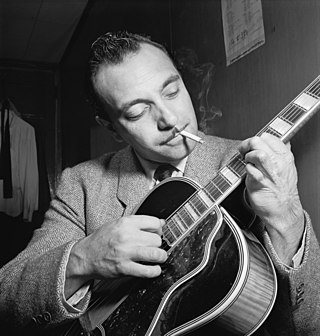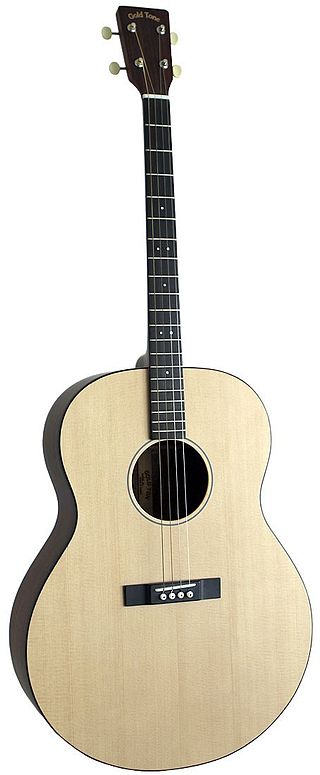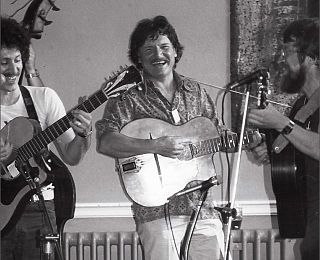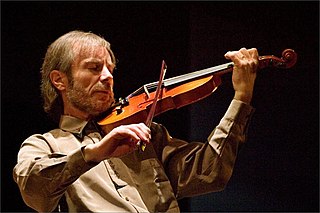
Jean Reinhardt, known by his Romani nickname Django, was a Belgian Manouche or Sinti jazz guitarist and composer. He was one of the first major jazz talents to emerge in Europe and has been hailed as one of its most significant exponents.

Jazz guitar may refer to either a type of electric guitar or a guitar playing style in jazz, using electric amplification to increase the volume of acoustic guitars.

In music performances, rhythm guitar is a technique and role that performs a combination of two functions: to provide all or part of the rhythmic pulse in conjunction with other instruments from the rhythm section ; and to provide all or part of the harmony, i.e. the chords from a song's chord progression, where a chord is a group of notes played together. Therefore, the basic technique of rhythm guitar is to hold down a series of chords with the fretting hand while strumming or fingerpicking rhythmically with the other hand. More developed rhythm techniques include arpeggios, damping, riffs, chord solos, and complex strums.

Bebop or bop is a style of jazz developed in the early to mid-1940s in the United States. The style features compositions characterized by a fast tempo, complex chord progressions with rapid chord changes and numerous changes of key, instrumental virtuosity, and improvisation based on a combination of harmonic structure, the use of scales and occasional references to the melody.

A jazz band is a musical ensemble that plays jazz music. Jazz bands vary in the quantity of its members and the style of jazz that they play but it is common to find a jazz band made up of a rhythm section and a horn section.

Charles Henry Christian was an American swing and jazz guitarist. He was among the first electric guitarists and was a key figure in the development of bebop and cool jazz. He gained national exposure as a member of the Benny Goodman Sextet and Orchestra from August 1939 to June 1941. His single-string technique, combined with amplification, helped bring the guitar out of the rhythm section and into the forefront as a solo instrument. For this, he is often credited with leading to the development of the lead guitar role in musical ensembles and bands.
The Hot Five was Louis Armstrong's first jazz recording band led under his own name.

David Anthony Rice was an American bluegrass guitarist. He was an influential acoustic guitar player in bluegrass, progressive bluegrass, newgrass and acoustic jazz. He was inducted into the International Bluegrass Music Hall of Fame in 2013.

The Selmer guitar — often called a Selmer-Maccaferri or just Maccaferri by English speakers, as early British advertising stressed the designer rather than manufacturer — is an unusual acoustic guitar best known as the favored instrument of Django Reinhardt. Selmer, a French manufacturer, produced the instrument from 1932 to about 1952.

Henri Selmer Paris is a French enterprise, manufacturer of musical instruments based at Mantes-la-Ville near Paris. Founded in 1885, it is known as a producer of professional-grade woodwind and brass instruments, especially saxophones, clarinets and trumpets. Henri Selmer Paris used to be family-owned but was sold to Argos-Wityu in 2018.

The tenor guitar or four-string guitar is a slightly smaller, four-string relative of the steel-string acoustic guitar or electric guitar. The instrument was initially developed in its acoustic form by Gibson and C.F. Martin so that players of the four-string tenor banjo could double on guitar.

William Charles "Diz" Disley was an Anglo-Canadian jazz guitarist and banjoist. He is best known for his acoustic jazz guitar playing, strongly influenced by Django Reinhardt, for his contributions to the UK trad jazz, skiffle and folk scenes as a performer and humorist, and for his collaborations with the violinist Stéphane Grappelli.

Gypsy jazz is a musical idiom inspired by the Romani jazz guitarist Jean "Django" Reinhardt (1910–1953), in conjunction with the French jazz violinist Stéphane Grappelli (1908–1997), as expressed by their group the Quintette du Hot Club de France. The style has its origins in France and the Manouche clan of Romanis, and has remained popular amongst this clan. Gypsy jazz is often called by the French name "jazz manouche", or alternatively, "manouche jazz" in English-language sources.
Jazz guitarists are guitarists who play jazz using an approach to chords, melodies, and improvised solo lines which is called jazz guitar playing. The guitar has fulfilled the roles of accompanist and soloist in small and large ensembles and also as an unaccompanied solo instrument.

Jazz violin is the use of the violin or electric violin to improvise solo lines. Early jazz violinists included: Eddie South, who played violin with Jimmy Wade's Dixielanders in Chicago; Stuff Smith; and Claude "Fiddler" Williams. Joe Venuti was popular for his work with guitarist Eddie Lang during the 1920s. Improvising violinists include Stéphane Grappelli and Jean-Luc Ponty. In jazz fusion, violinists may use an electric violin plugged into an instrument amplifier with electronic effects.
The Stetsons was an Australian country and western band formed by members of GANGgajang, Mental As Anything and Flying Emus. They released a self-titled album in 1987 and played a few live shows, including at the Tamworth music Festival for the next two years. In 1997 the bands producer, Graham "Buzz" Bidstrup and his friend Andrew Richardson, made a record with former ABC JJJ sound engineer Keith Walker in Jimmy Barnes old studio. The album was called Their Most Successful Album...Ever. The band released three singles with videos and the debut single "There's A Train In My Head" was used in Crocodile Dundee II. Their music was also heard in the film Tenderhooks.
Dixieland jazz, also referred to as traditional jazz, hot jazz, or simply Dixieland, is a style of jazz based on the music that developed in New Orleans at the start of the 20th century. The 1917 recordings by the Original Dixieland Jass Band, fostered awareness of this new style of music.

The Red Onion Jazz Band was a trad jazz band formed in Melbourne (Australia) in the early 1960s and was also known as "The Red Onions" and "The Onions".
Trudy Kerr is an Australian-born jazz musician, teacher, radio presenter and label owner. Since 1997 she has released ten studio albums and a compilation album, Contemplation. Kerr has performed concerts in the UK, continental Europe, East Asia and Australia. She resides in Beckenham with her husband, Geoff Gascoyne, a fellow jazz musician who plays double bass.
Michael Cooper is an English guitarist and singer-songwriter. Initially coming to attention as a country blues performer, his later work also straddles jazz, Polynesian, ambient, and various experimental and improvisational styles.















